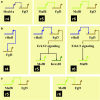The gene regulatory networks underlying formation of the auditory hindbrain
- PMID: 25332098
- PMCID: PMC11113740
- DOI: 10.1007/s00018-014-1759-0
The gene regulatory networks underlying formation of the auditory hindbrain
Abstract
Development and evolution of auditory hindbrain nuclei are two major unsolved issues in hearing research. Recent characterization of transgenic mice identified the rhombomeric origins of mammalian auditory nuclei and unraveled genes involved in their formation. Here, we provide an overview on these data by assembling them into rhombomere-specific gene regulatory networks (GRNs), as they underlie developmental and evolutionary processes. To explore evolutionary mechanisms, we compare the GRNs operating in the mammalian auditory hindbrain with data available from the inner ear and other vertebrate groups. Finally, we propose that the availability of genomic sequences from all major vertebrate taxa and novel genetic techniques for non-model organisms provide an unprecedented opportunity to investigate development and evolution of the auditory hindbrain by comparative molecular approaches. The dissection of the molecular mechanisms leading to auditory structures will also provide an important framework for auditory processing disorders, a clinical problem difficult to tackle so far. These data will, therefore, foster basic and clinical hearing research alike.
Figures





Similar articles
-
Comparative Analysis of Gene Regulatory Network Components in the Auditory Hindbrain of Mice and Chicken.Brain Behav Evol. 2016;88(3-4):161-176. doi: 10.1159/000449447. Epub 2016 Nov 19. Brain Behav Evol. 2016. PMID: 27866201
-
Conserved and divergent development of brainstem vestibular and auditory nuclei.Elife. 2018 Dec 19;7:e40232. doi: 10.7554/eLife.40232. Elife. 2018. PMID: 30566077 Free PMC article.
-
Activity-dependent formation of a vesicular inhibitory amino acid transporter gradient in the superior olivary complex of NMRI mice.BMC Neurosci. 2017 Oct 26;18(1):75. doi: 10.1186/s12868-017-0393-9. BMC Neurosci. 2017. PMID: 29073893 Free PMC article.
-
Perineuronal nets in the auditory system.Hear Res. 2015 Nov;329:21-32. doi: 10.1016/j.heares.2014.12.012. Epub 2015 Jan 9. Hear Res. 2015. PMID: 25580005 Review.
-
Developmental gene regulatory network evolution: insights from comparative studies in echinoderms.Genesis. 2014 Mar;52(3):193-207. doi: 10.1002/dvg.22757. Epub 2014 Mar 6. Genesis. 2014. PMID: 24549884 Review.
Cited by
-
Evolutionary trends in directional hearing.Curr Opin Neurobiol. 2016 Oct;40:111-117. doi: 10.1016/j.conb.2016.07.001. Epub 2016 Jul 22. Curr Opin Neurobiol. 2016. PMID: 27448850 Free PMC article. Review.
-
Neural stem cells deriving from chick embryonic hindbrain recapitulate hindbrain development in culture.Sci Rep. 2018 Sep 17;8(1):13920. doi: 10.1038/s41598-018-32203-w. Sci Rep. 2018. PMID: 30224755 Free PMC article.
-
Optogenetic Control of Neural Circuits in the Mongolian Gerbil.Front Cell Neurosci. 2018 Apr 24;12:111. doi: 10.3389/fncel.2018.00111. eCollection 2018. Front Cell Neurosci. 2018. PMID: 29740286 Free PMC article.
-
Expression pattern of cochlear microRNAs in the mammalian auditory hindbrain.Cell Tissue Res. 2021 Feb;383(2):655-666. doi: 10.1007/s00441-020-03290-x. Epub 2020 Nov 6. Cell Tissue Res. 2021. PMID: 33156384 Free PMC article.
-
CRABP-I Expression Patterns in the Developing Chick Inner Ear.Biology (Basel). 2023 Jan 10;12(1):104. doi: 10.3390/biology12010104. Biology (Basel). 2023. PMID: 36671796 Free PMC article.
References
-
- Abouheif E. Developmental genetics and homology: a hierarchical approach. Trends Ecol Evol. 1997;12:405–408. - PubMed
-
- Abouheif E. Establishing homology criteria for regulatory gene networks: prospects and challenges. Novartis Found Symp. 1999;222:207–221. - PubMed
-
- Alexander T, Nolte C, Krumlauf R. Hox genes and segmentation of the hindbrain and axial skeleton. Annu Rev Cell Dev Biol. 2009;25:431–456. - PubMed
Publication types
MeSH terms
Substances
LinkOut - more resources
Full Text Sources
Other Literature Sources

